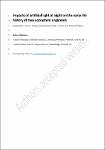Impacts of artificial light at night on the early life history of two ecosystem engineers
| dc.contributor.author | Tidau, S | |
| dc.contributor.author | Brough, FT | |
| dc.contributor.author | Gimenez, L | |
| dc.contributor.author | Jenkins, SR | |
| dc.contributor.author | Davies, TW | |
| dc.date.accessioned | 2023-07-03T10:36:00Z | |
| dc.date.available | 2023-07-03T10:36:00Z | |
| dc.date.issued | 2023-12-18 | |
| dc.identifier.issn | 1471-2970 | |
| dc.identifier.issn | 1471-2970 | |
| dc.identifier.other | ARTN 20220363 | |
| dc.identifier.uri | https://pearl.plymouth.ac.uk/handle/10026.1/21016 | |
| dc.description.abstract |
Sessile marine invertebrates play a vital role as ecosystem engineers and in benthic-pelagic coupling. Most benthic fauna develop through larval stages and the importance of natural light cycles for larval biology and ecology is long-established. Natural light-dark cycles regulate two of the largest ocean-scale processes that are fundamental to larvae’s life cycle: the timing of broadcast spawning for successful fertilisation and diel vertical migration for foraging and predator avoidance. Given the reliance on light and the ecological role of larvae, surprisingly little is known about the impacts of artificial light at night (ALAN) on the early life history of habitat-forming species. We quantified ALAN impacts on larval performance (survival, growth, development) of two cosmopolitan ecosystem engineers in temperate marine ecosystems, the mussel Mytilus edulis and the barnacle Austrominius modestus. Higher ALAN irradiance reduced survival in both species (57% and 13%, respectively). ALAN effects on development and growth were small overall, and different between species, time-points, and parentage. Our results show that ALAN adversely affects larval survival and reiterates the importance of paternal influence on offspring performance. ALAN impacts on the early life stages of ecosystem engineering species have implications not only for population viability but also the ecological communities these species support. | |
| dc.format.extent | 20220363- | |
| dc.format.medium | Print-Electronic | |
| dc.language | en | |
| dc.publisher | The Royal Society | |
| dc.subject | development | |
| dc.subject | growth | |
| dc.subject | larvae ecology | |
| dc.subject | light pollution | |
| dc.subject | supply-side ecology | |
| dc.subject | survival | |
| dc.title | Impacts of artificial light at night on the early life history of two ecosystem engineers | |
| dc.type | journal-article | |
| dc.type | Article | |
| plymouth.author-url | https://www.ncbi.nlm.nih.gov/pubmed/37899009 | |
| plymouth.issue | 1892 | |
| plymouth.volume | 378 | |
| plymouth.publication-status | Published | |
| plymouth.journal | Philosophical Transactions of the Royal Society B: Biological Sciences | |
| dc.identifier.doi | 10.1098/rstb.2022.0363 | |
| plymouth.organisational-group | |Plymouth | |
| plymouth.organisational-group | |Plymouth|Faculty of Science and Engineering | |
| plymouth.organisational-group | |Plymouth|Faculty of Science and Engineering|School of Biological and Marine Sciences | |
| plymouth.organisational-group | |Plymouth|Users by role | |
| plymouth.organisational-group | |Plymouth|Users by role|Academics | |
| dc.publisher.place | England | |
| dcterms.dateAccepted | 2023-06-26 | |
| dc.date.updated | 2023-07-03T10:35:58Z | |
| dc.rights.embargodate | 2023-11-1 | |
| dc.identifier.eissn | 1471-2970 | |
| dc.rights.embargoperiod | ||
| rioxxterms.version | Accepted Manuscript | |
| rioxxterms.versionofrecord | 10.1098/rstb.2022.0363 |


